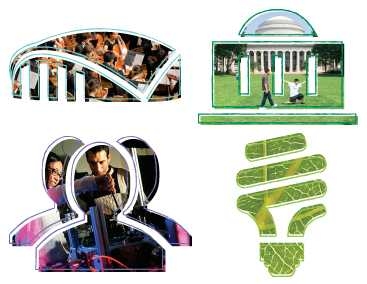How can nail polish remover and a pickle light up a room? How much energy does your Kindle or iPad consume? And what in the world is a water bear? The answers to all these questions and more can be found this Saturday, April 30, at the MIT Open House — a one-day event that offers a glimpse into the ideas, technologies and devices developed across campus.
The Open House — which is free and open to the public and the MIT community — will take place from 11 a.m. until 4 p.m. on Saturday; use of public transportation to get to campus is highly encouraged, as thousands are expected to come to campus and parking will be limited. The Open House is one of the centerpiece events of MIT's 150th anniversary celebration, and it also kicks off the annual Cambridge Science Festival, which will run through May 8.
“MIT is a big, fascinating, dynamic place, focused on inventing the future, from energy to economics, aeronautics to architecture, biomedicine to business, computing to composing,” MIT President Susan Hockfield says. “With Saturday’s Open House, we’re welcoming our neighbors, of every age and from all across Greater Boston, to explore how we think and what we’re working on.”
The event will start, quite literally, with a bang. At 11 a.m., students from the Department of Aeronautics and Astronautics will start firing water-powered bottle rockets from Briggs Field. At the same time, a pair of Black Hawk helicopters courtesy of the Rhode Island Army National Guard and MIT’s Army ROTC program will land on campus for a couple of hours, giving visitors an up-close view of the military aircraft. Meanwhile, departments and labs across campus will open their doors to the public, revealing everything from the mathematics of origami, to iPhone-controlled aerial vehicles, to a prototype of the first practical flying car.
“This is a wonderful way to celebrate MIT’s 150th birthday,” says Elizabeth Young, MIT's associate dean for new student programming and holistic initiatives, who co-led the planning group for the Open House along with Paul Lagace, professor of aeronautics and astronautics and engineering systems. “Part of this endeavor was getting departments and labs to look internally at themselves and say, ‘We know what we take for granted in our work — now how can we show this to people outside of MIT?'”
The self-reflection has paid off, and the Open House schedule is packed with activities and attractions for all ages. Kids will find plenty to explore, including paper-airplane contests, an interactive magical polymer demonstration and a self-guided scavenger hunt. High school students can watch a robotics demonstration or fly an unmanned aerial vehicle (UAV). And visitors of all ages can visit the Space Systems Lab, where they can pilot basketball-sized satellites in the lab.
Visitors can take tours of MIT’s research laboratories as well as art galleries, and attend scheduled talks by MIT faculty and others. Throughout the day, music and theater groups will give short performances, and the MIT Festival Jazz Ensemble will cap off the Open House with a concert in Kresge Auditorium later in the evening.
The more than 150 activities taking place across campus are divided into nine categories:
While open houses aren't new at MIT — it's a tradition dating back to the 1920s — this will be the first such event in more than 30 years. Young says that while times have changed significantly since the last open house, in 1978, there is a common theme that spans the decades: Each open house is meant as much for MIT to get to know itself as it is for the community to get to know MIT.
“This is one of those events that touches every single piece of this campus, from tenured faculty down to freshmen,” Young says. “On Saturday, a music student can go see the 2.007 Robot Competition, and an engineering professor can attend a gamelan performance, and it allows MIT to explore within itself.”
The Open House — which is free and open to the public and the MIT community — will take place from 11 a.m. until 4 p.m. on Saturday; use of public transportation to get to campus is highly encouraged, as thousands are expected to come to campus and parking will be limited. The Open House is one of the centerpiece events of MIT's 150th anniversary celebration, and it also kicks off the annual Cambridge Science Festival, which will run through May 8.
“MIT is a big, fascinating, dynamic place, focused on inventing the future, from energy to economics, aeronautics to architecture, biomedicine to business, computing to composing,” MIT President Susan Hockfield says. “With Saturday’s Open House, we’re welcoming our neighbors, of every age and from all across Greater Boston, to explore how we think and what we’re working on.”
The event will start, quite literally, with a bang. At 11 a.m., students from the Department of Aeronautics and Astronautics will start firing water-powered bottle rockets from Briggs Field. At the same time, a pair of Black Hawk helicopters courtesy of the Rhode Island Army National Guard and MIT’s Army ROTC program will land on campus for a couple of hours, giving visitors an up-close view of the military aircraft. Meanwhile, departments and labs across campus will open their doors to the public, revealing everything from the mathematics of origami, to iPhone-controlled aerial vehicles, to a prototype of the first practical flying car.
“This is a wonderful way to celebrate MIT’s 150th birthday,” says Elizabeth Young, MIT's associate dean for new student programming and holistic initiatives, who co-led the planning group for the Open House along with Paul Lagace, professor of aeronautics and astronautics and engineering systems. “Part of this endeavor was getting departments and labs to look internally at themselves and say, ‘We know what we take for granted in our work — now how can we show this to people outside of MIT?'”
The self-reflection has paid off, and the Open House schedule is packed with activities and attractions for all ages. Kids will find plenty to explore, including paper-airplane contests, an interactive magical polymer demonstration and a self-guided scavenger hunt. High school students can watch a robotics demonstration or fly an unmanned aerial vehicle (UAV). And visitors of all ages can visit the Space Systems Lab, where they can pilot basketball-sized satellites in the lab.
Visitors can take tours of MIT’s research laboratories as well as art galleries, and attend scheduled talks by MIT faculty and others. Throughout the day, music and theater groups will give short performances, and the MIT Festival Jazz Ensemble will cap off the Open House with a concert in Kresge Auditorium later in the evening.
The more than 150 activities taking place across campus are divided into nine categories:
- Air and Space Flight;
- Architecture, Planning and Design;
- Arts, Humanities, and Social Sciences;
- Energy, Environment, and Sustainability;
- Engineering, Technology, and Invention;
- Entrepreneurship and Management;
- Life Sciences and Biotechnology;
- The Sciences;
- MIT Learning, Life, and Culture.
While open houses aren't new at MIT — it's a tradition dating back to the 1920s — this will be the first such event in more than 30 years. Young says that while times have changed significantly since the last open house, in 1978, there is a common theme that spans the decades: Each open house is meant as much for MIT to get to know itself as it is for the community to get to know MIT.
“This is one of those events that touches every single piece of this campus, from tenured faculty down to freshmen,” Young says. “On Saturday, a music student can go see the 2.007 Robot Competition, and an engineering professor can attend a gamelan performance, and it allows MIT to explore within itself.”






